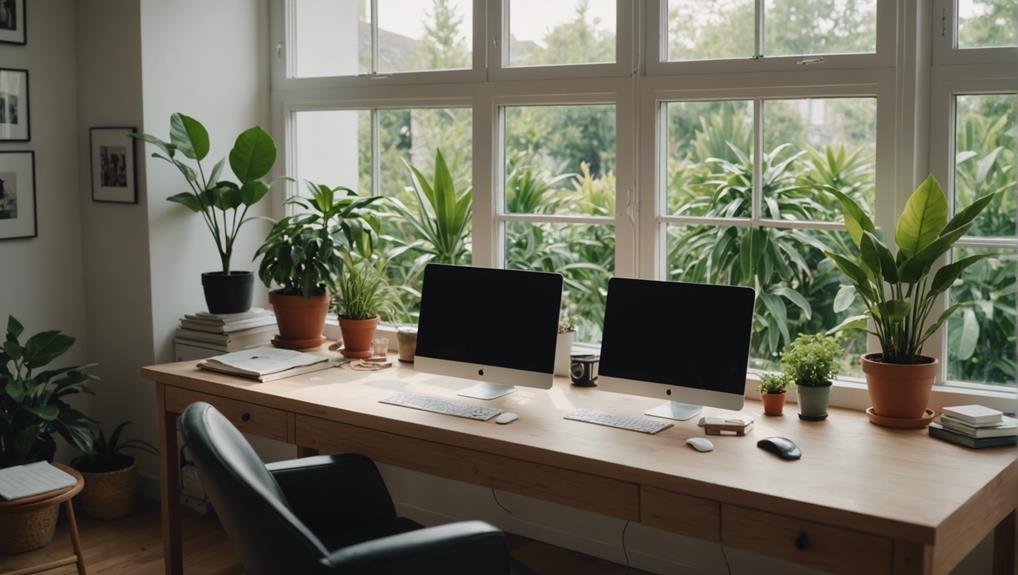Our environment shapes our behavior in subtle but powerful ways. For example, buildings can affect how we think, while natural light and open spaces can lift our mood and increase productivity.
Simple visual cues, like keeping a water bottle within reach, can encourage us to drink more water. Similarly, background music can influence how well we concentrate.
Making practical changes, such as organizing our desks and setting up specific areas for different tasks, can make our routines smoother and improve our well-being. High ceilings and flexible furniture can boost our creativity.
Adding natural elements like sunlight and plants can reduce stress and enhance mental health. Explore how these small adjustments can significantly improve your daily life.
Brains and Buildings
Our brains are significantly influenced by the buildings we live and work in, shaping our behavior in many ways. Architectural design can greatly affect our cognitive functions.
For example, spaces with natural light and open areas can boost our mood and productivity. The way a space is designed impacts our daily lives by influencing how we interact with our environment and each other. Large rooms with high ceilings can encourage creative thinking, while small, cramped spaces might hinder it.
Understanding how spatial design affects behavior helps us create environments that promote positive actions and reduce stress. By focusing on these elements, we can improve our surroundings to better support our mental and emotional well-being.
Environmental Triggers
Environmental triggers significantly influence our daily habits and behaviors. Our surroundings constantly send us signals that affect our actions, often without our awareness. Understanding these environmental cues can make behavior change more achievable.
Here are some examples:
- Visual reminders: Keeping a water bottle on your desk can help you remember to drink water throughout the day.
- Sound cues: Playing background music can either boost your concentration or help you relax, depending on the type of music.
- Space organization: How you arrange furniture can either promote or hinder social interaction.
Recognizing and adjusting these environmental factors can help you create a more supportive environment for your goals.
Practical Changes

Making practical changes to our environment can significantly improve our ability to form new habits and boost our well-being. Let's start with desk organization. Keeping our desks tidy helps create a workspace that promotes focus and productivity. Decluttering can minimize distractions, making it easier to concentrate on tasks.
The layout of our rooms is also crucial. Arranging furniture to allow natural light and easy movement can enhance our mood and efficiency. Simple adjustments, like placing frequently used items within reach and creating dedicated spaces for specific activities, can streamline our routines.
For example, if you often read, consider setting up a cozy reading nook with a comfortable chair and good lighting. By thoughtfully organizing our environment, we set ourselves up for success in both personal and professional areas.
Boosting Creativity
To boost creativity, we must focus on the spaces where we work and think. The environment around us can significantly impact our ability to come up with new ideas. By carefully designing these spaces, we can create an atmosphere that inspires creativity.
- High ceilings and open spaces: These features help us think more broadly and come up with new ideas. For example, an office with high ceilings and open areas can make brainstorming sessions more effective.
- Natural light and fresh air: These elements can improve our problem-solving skills and overall creativity. A workspace with large windows and good ventilation can make us feel more energized and creative.
- Flexible furniture arrangements: Movable furniture lets us change the space based on what we're working on, which can enhance our creative thinking. For instance, using adjustable desks and chairs can help us set up different layouts for various tasks.
Well-Being Impact

Our environment greatly impacts our well-being, affecting our mood and productivity.
Natural light and greenery can significantly improve our mood and reduce stress. For example, working in a room with plenty of sunlight can make us feel happier and more efficient.
Similarly, having plants around us can create a calming atmosphere and help relieve stress.
By thoughtfully designing our spaces to include these elements, we can boost our mental health and daily functioning.
Let's make the most of our surroundings to support our well-being and enhance our productivity.
Conclusion
We've looked at how our surroundings quietly influence our actions and thoughts. By making small changes like adding natural light and keeping our spaces tidy, we can boost productivity, creativity, and well-being.
Some might see these changes as minor, but even small tweaks can greatly impact our daily lives. As architects, designers, and individuals, let's work on improving our environments. This way, we won't just enhance our spaces but also improve our overall quality of life.
